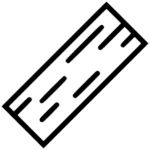FREQUENTLY ASKED QUESTIONS
Porcelain tile is a type of ceramic. It is made from a dense mix of clay minerals and water. The clay is often made of feldspar, kaolin, and quartz. This combination of clay, higher-pressure during construction, high temperature it is fired at 2,200-2,500 degrees Fahrenheit makes porcelain denser and more water resistant than ceramic tiles.
Porcelain is more durable than ceramic, meaning it is less likely to chip. It is also can even be used outdoors on lanais, pool decks, etc!
Ceramic tile is one of the most common types of tiles, and it is a broad category that includes many subsets of tile. It is made from a solution of clay minerals and water, then pressed into a tile shape and fired in a kiln typically around 1400-1650 degrees Fahrenheit. What separates a ceramic tile from porcelain is the water absorption which is greater then 0.5%, which means it has a good water resistance which could be used interior but should be avoided in exterior applications.
Floor tile is made to be thick and sturdy so it can withstand foot traffic. Meanwhile, wall tile is thinner and lighter for easier installation. All floor tiles can be installed on walls giving you more options.
Glazed tile is water-resistant when installed properly, but not all glazed tiles are suitable for use in high-moisture areas like bathtubs, showers, and around pools.
Ceramic tile is created using a mixture of clay and water. A dryer removes moisture from the clay before pressing the mixture into a tile shape. It is then left on a rack to dry and is called “green tile” or “greenware” at this point, because it hasn’t been fired in a kiln.
Once the tile has dried, a printer will add the color and pattern before adding the top glaze layer. The glaze protects the imagery and ensures that the tile is non-porous. The ceramic tile will remain porous if not glazed.
To finish, ceramic is fired 1400-1650F to set the glaze and bake out any remaining moisture.
To make a porcelain tile, a dryer removes excess moisture from the clay mixture, and then the tile is then pressed into shape at extremely high pressure before left to dry on a rack. Once dried, a high-tech inkjet printer will add a layer that includes the colors and pattern. At this point the tile is glazed to protect this image, though porcelain can also be left unglazed.
Finally, porcelain is fired at an 2500F, which is higher than ceramic. This temperature both sets the glaze and bakes out the remaining moisture, creating an impermeable surface.
- Glazed: The glaze is like the finishing touch to your tile. It works like a bodyguard to protect your tile from moisture and stains. Most ceramic tiles are glazed, but people sometimes prefer the natural, earthy look of unglazed tiles. Additionally, the glaze can cause these tiles to be more slippery when wet so we recommend using a textured tile if you plan to use a glazed tile in a bathroom or water-prone area.
- Polished: For a truly flawless surface, polished porcelain floor tiles are ground down to a high polish just like natural stones like marble and granite. A polish topcoat finish is added to protect your tile from absorbing dirt and debris, offering you a sharper-looking floor with less maintenance and that ‘glassy’ look.
- Unglazed: Unglazed ceramic tiles have no extra finish added after firing. They often look more earthy and natural than glazed ceramic tiles, but they are not quite as impervious to liquid or as easy to maintain. While these tiles can be (and are) still used in rooms such as bathrooms and kitchens, they will require more maintenance than their safeguarded glazed counterparts.
Clear loose dust and dirt by sweeping with a broom and dustpan. You could also use a vacuum with a soft-bristled brush attachment. Then mop the tile using warm water and a cleaning solution appropriate for your floor (check the manufacturer’s instructions).
As you mop, you will need to refresh the water bucket whenever the water starts looking too cloudy. Once the mopping is completed, dry the tile with a microfiber cloth to prevent any water spots from air-drying.
“Natural Stone” refers to several products quarried from the earth, used over thousands of years as building materials and decorative enhancements. These products include Granite, Marble, Limestone, Travertine, Slate, Quartzite, Sandstone, Adoquin, Onyx, and others. They are more than just rocks – natural stone is hand selected from the best, most consistent sources for durability and beauty.
Natural stone products differ in composition, color, and texture even among pieces from the same source. This is usually considered a benefit, lending itself to one-of-a-kind designs and distinctive, dramatic applications.
Natural Stone can be used on nearly every surface both inside and outside the home, including floors, kitchen countertops, vanity tops, bathrooms, patios, walkways, fireplaces, facades, wall cladding, and garden landscaping.
Natural stones are quarried directly from the earth’s crust, and every piece is unique. The only processing, they need is shaping into various forms, sizes and finishes.
Luxury vinyl plank is a vinyl flooring that looks like wood. It is waterproof, which makes it ideal for installing in kitchens and bathrooms.
Yes, vinyl plank flooring can be installed on stairs. You will need to purchase stair nose that coordinates with your flooring choice. (Stair nose is the part that goes on the edge of each step.)
Yes, you can put heavy furniture on vinyl plank flooring. You do, however, need to take measures to protect your flooring from damage. Use felt pads under furniture legs, especially under chairs. If you have a piano, or anything heavy on casters (wheels), you’ll want to use caster cups to distribute the weight.
Yes, you can put rugs on vinyl plank flooring, but you need to make sure it is the right kind. You don’t want anything that has a rubber backing unless it specifically says it’s safe for vinyl flooring. The same goes for rug pads. The chemicals can react with the vinyl flooring and turn it yellow. Use non-staining mats only.
Pre-Sales Question?
If you have more pre-sales questions, please contact us via email at generalinfo@wholesaletilesupply.com






 Collections
Collections



 Paver
Paver

